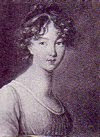
One of the greatest mysteries in the world of knitting lies in the stitches of a magnificent petticoat, hand-knit in two-ply cream wool, depicting animals, plants and foliage and what looks like insects, which is in the textile collection of the Victoria and Albert Museum (Museum Number T.177-1926;
http://collections.vam.ac.uk/item/O10318/petticoat/)
As the museum online catalogue entry states, it is “an extraordinary feat of knitting skill unparalleled in any other known collection.”*
The first mystery is that it is knitted in the round, with no seams, measuring roughly 122” in width and almost 30” long which would seem to be too large to knit by either hand or frame. “Despite the large surface area, the pattern does not repeat.”* which is another breathtaking element.
All of the knitting is done in plain (stockinette) or raised (purl) stitch, creating seed stitches in some areas, all on a background of stockinette. The raised stitch was the most common way of creating a design on knitted items in the 18th century, knitted lace existing but rare and twist or cable stitches slowly emerging, more so in the 19th century. Another mystery is the size of the needles/wires, both in width and length. The petticoat is also catalogued as “unfinished”* but this may mean it does not have a waistband sewn on – I cannot say as I have never seen the piece in person.
The V&A has classified the petticoat as possibly being of Dutch origin from the first half of the 18th century, stating that a “similar garment was a petticoat knitted in a variety of abstract patterns within a diamond-shaped grid. Sold at Christies auction house in 1981, it too dated from the early 18th century and had both Dutch and English connections.”*
Had it ever been worn, it could have been under a skirt that was split open in a triangle or rectangle (depending on the fashion) in the middle of the front, displaying the fine knitted design as quilted petticoats were, as well as providing warmth over linen undergarments.

There are at least twenty-two different birds and animals depicted, including a rhinoceros and an elephant, many of them in the distinctive style of those found in printed images of the eras. The graceful lines of the plants and branches as well as the tails of the birds are also reminiscent of the prints on palampore hangings or drapery for beds and windows, often reproduced in the fabulous crewel stitchery of the 17th and 18th century. I have to admit these patterns are favourites of mine whether I am stitching or quilting them as seen in this palampore quilt I made about fifteen years ago.
I have, however, long wanted to knit some of the images in this petticoat. The main problem with doing that is that so little of it is available in photographs, and those always in sections. In the catalogue from the exhibition, Knit One, Purl One (Victoria and Albert Museum 01/01/1985-31/12/1985), the featured photograph, spread over two pages, shows the largest area that I have ever found but the catalogue itself is only 8 ½” tall by 8” wide. The images are very small and thus very, very difficult to see in order to count the stitches. Using the other few available images from the web, I have been trying to chart some of the creatures but then decided to begin with an easier version.

The Art of Knitting – Garments for Today from Patterns of the Past (edited by Eve Harlow, Glasgow and London: William Collins Sons and Company Limited, 1977) contains a pattern for a scarf with a chart of a parrot. The charting for the scarf motif is fairly faithful on a larger scale to the original although the head on the original is far more detailed and the stitch count on the whole original bird is, of course, greater. At least, however, I now have something to work and build out from, and I have already changed some of the stitches for the head to try to better capture the beak and the eye area of the petticoat’s parrot. I was not very successful, though, as far more stitches are required for all of the different textures. I can, however, try this design again, also working from the photograph of the original section in this book, which is possibly the best photograph I have ever seen of any part of the petticoat.
The Art of Knitting’s description of the petticoat varies slightly in measurements and states a gauge/tension of 22 stitches and 36 rows to the inch with approximately 2650 stitches to the row. My segment of the petticoat was knit on 0.75mm/US 00 needles, using KnitPicks Palette in Cream, with a gauge/tension of 12 ½” stitches and 16 ½ rows to the inch, and a slip and seed stitch border all round. The whole piece measures, on the blocking board, 7 ½” tall and 5 ½” wide. The parrot is 6 ½” long from the top of its head to the tip of its tail.
I took many photographs before I was able to get two halfway decent ones which showed the stitches. The tan-toned one at the top was taken in total darkness but is the sharpest in detail, and the one at the end of this blog shows the finished piece though not as clearly as the other image.
In the beginning of this post, I called the petticoat magnificent. It is beyond that but I cannot come up with a better word to describe it. Each time I look at it, I am stunned yet again by the drafting and charting that must have gone into its production let alone the workmanship The Dutch were renowned for their superb knitting but this is beyond spectacular.

*All quotations are from http://collections.vam.ac.uk/item/O10318/petticoat/)























